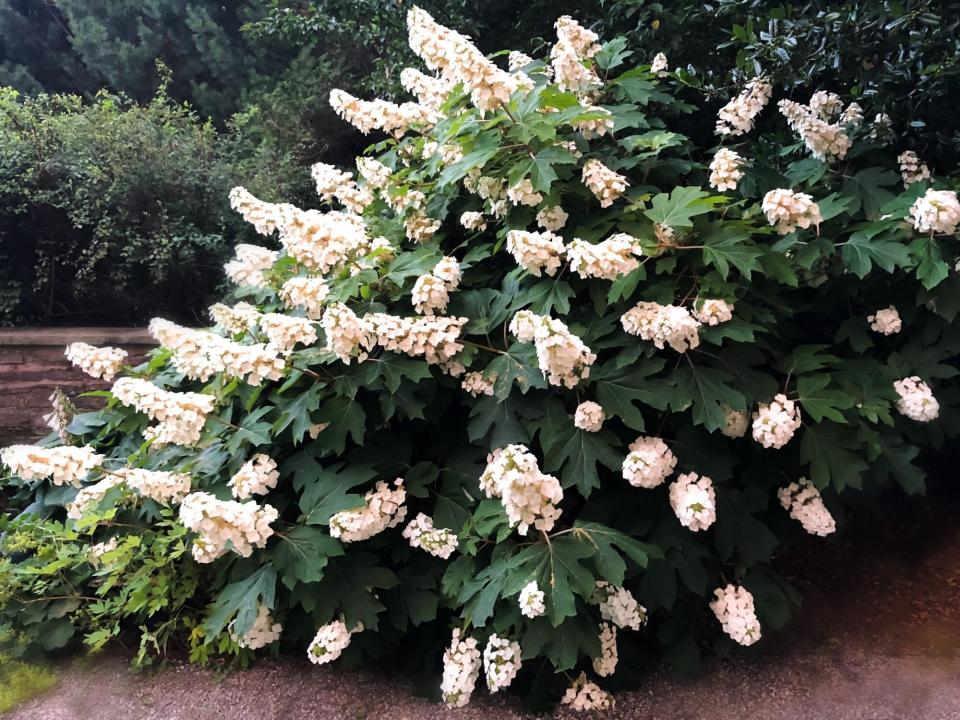Oakleaf Hydrangeas Are the Color-Changing Shrubs Your Garden Has Been Missing
Oakleaf hydrangea, or Hydrangea quercifolia, is a flowering shrub that can often be found on the East Coast of North America; they bloom beautifully everywhere from the southern tip of Vermont all the way down to the top of Florida. While their name might be familiar, it's important to note that these hydrangeas aren't like just any other shrub in the family, and it's their unique foliage that sets them apart. Two experts share their top tips for planting, growing, and caring for the blooms.
Related: How to Prune Hydrangeas

All About Oakleaf Hydrangeas
Oakleaf hydrangeas are a species of hydrangea that blooms in June with white flowers that often age into a beautiful pink or red color. "The flowers are fantastic, but one of my favorite attributes of an oakleaf hydrangea is the incredible foliage," explains Ryan McEnaney, spokesperson for First Editions® Shrubs & Trees. "The leaves are large and lobed (like an oak tree leaf, hence the name), and as fall settles into the garden, the leaves deepen to a show-stopping red and maroon color." McEnaney believes the leaves alone are worth planting this amazing native shrub because they put on a show in the fall by changing into a deep merlot color. In the winter, after they drop those leaves, you'll get a look at the plant's thicker stems and exfoliating bark. "My favorite variety is Jetstream™ Hydrangea because it stays a bit more compact than the species and many others available in garden centers," he says, adding that it remains manageable in your garden while retaining its incredible flower power.
How to Plant and Care for Oakleaf Hydrangeas
According to Ryan Zawojski, owner and lead designer of RYZ Designs, oakleaf varieties can grow up to 10 feet tall in the right conditions and do the best in USDA hardiness zones five through nine. "Oakleaf hydrangeas appreciate well-drained soil and morning sunlight (western light exposure)," he says. "They will only bloom on mature woody stems (the part of the branching that turns into a flakey wooden stem) that get enough sunlight." And you can skip fertilizer according to Zawojski, that is unless you start to notice that your plant looks droopy or is not blooming. "A fresh layer of cedar mulch is all you need sometimes because it is filled with nitrogen phosphorus potassium [that keeps] the pH level in check which is around level six or seven."
Since this type of hydrangea can tolerate full sun to part shade, McEnaney says they do especially well in woodland borders. "They're a great transition from a more formal garden bed to that more natural woodsy look," McEnaney says.
Where to Find Oakleaf Hydrangeas
Oakleaf hydrangeas can be grown from cuttings from mature shrubs, but you can generally find the shrubs in three-gallon pots at your local garden center; these can easily be planted straight into your garden, explains Zawojski. He recommends planting during spring, early summer, or early to late fall. "Do not plant shrubs in any harsh weather conditions like July and August, or January and February," he warns.
Pests and Problems
Unfortunately, you won't be the only one admiring your oakleaf hydrangeas. Zawojski says they're prone to attracting deer to the garden, as well. To keep four-legged friends from nibbling your plant, he recommends planting them in a fenced-in area, in a pot on your patio, or in an area that has been treated with a deer repellent spray. Otherwise, the critters are likely to make short work of your shrubs.

